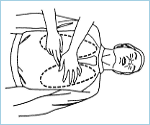Adult, child, and infant CPR & AED Course
Learn CPR. For Life™



ADULT CHEST COMPRESSIONS
The universal rate for compressions in all cardiac arrest victims (adult, child, or infant) is 100 to 120 per minute. Likewise, the compressions-to-ventilation ratio for 1 rescuer (30:2) is the same for adult, child, and infant victims. For 2 rescuers, the compressions-to-ventilation ratio for adult, child or infant is 15:2.
When you give chest compressions:
- compress, rapidly, at a rate of 100 to 120 compressions per minute
- compress the chest hard, at least 2 inches (5 cm)
- allow the chest to recoil fully after each compression
- minimize interruptions in compressions
Do not move victim unless he is face down, appears to be in imminent danger, or on a soft or otherwise unsuitable surface such as a bed or bathtub.
Performing chest compressions:
- the victim must be face up on a firm, flat surface. If you must move or roll them over, be extremely careful if you suspect head or neck injury
- stand or kneel at the victim’s side

- position your hands and body to perform chest compressions:
- place the heel of one hand in the center of the victim’s chest, on the lower half of the breastbone (sternum)
- place the heel of your other hand on top of the first hand

- straighten your arms and position your shoulders directly over your hands
- begin chest compressions at a rate of 100 to 120 per minute
- press fast and hard, at least 2 inches (5 cm) making sure you push straight down on the victim’s breastbone
- at the end of each compression, allow the chest to recoil completely